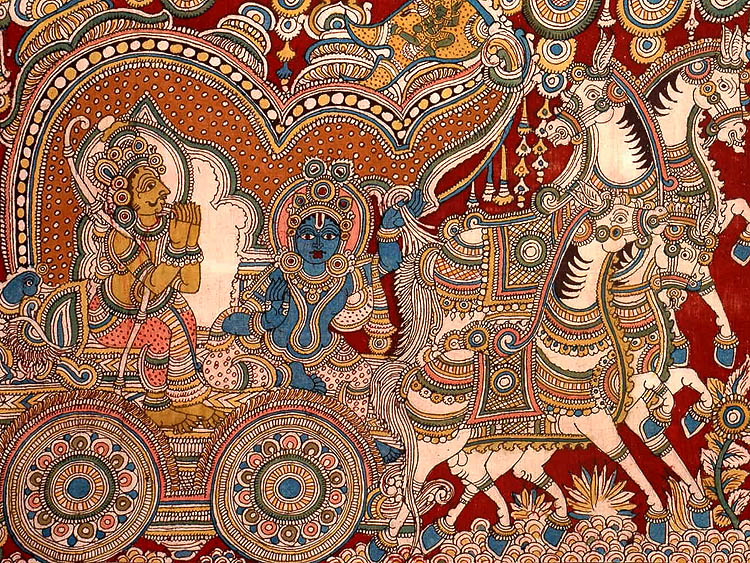Introduction-
Kalamkari is the earliest and one of the most complex techniques of fabric printing using vegetable dyes and minerals.
According to Wikipedia, Kalamkari or Qalamkari is a type of hand-painted or block-printed cotton textile, produced in parts of India. The word is derived from the Persian words kalam (pen) and kari (craftmanship), meaning drawing with a pen. The craft made at Pedana near by Machilipatnam in Krishna district, Andhra Pradesh, evolved with patronage of the Mughals and the Golconda sultanate. The art has certainly received centuries of appreciation and patronage from people around the world. According to some sources the name Kalamkari was most likely derived from the trade relationships between Persian and Indian merchants as early as 10th century CE. Portuguese merchants called this kind of fabric printing “Pintado”. The Dutch called it “Sitz” and the British found it easy to call this textile printing technique “Chintz”. The name Kalamkari is however universally accepted and enjoyed by the fabric lovers since many decades.
Motifs and Inspiration-
Kalamkari in India is native of Sri Kalahasthi village in Andhra Pradesh, India. Adopted by other Indian states such as Gujarat, Tamil Nadu and Rajasthan, motifs and techniques were evolved based on use and need.
Andhra Kalamkari Patterns-
Andhra Kalamkari takes its inspiration from the historical architecture such as temples, forts and palaces. The motifs include animals and birds like Lion, Peacock, Elephant and Indian gods and goddesses.

Hand painted Kalamkari – work in process
Image source: indianmuslimobserver.com
Image source: indianmuslimobserver.com

Kalamkari – Motif outliningImage source: gujaratkalamkari.blogspot.in
Gujarat and Other Indian Kalamkari Patterns-
Gujarat Kalamkari motifs are inspired by the gods and goddesses such as – sri Jagannath, lord Krishna, and lord Ganesha , goddesses Saraswati, goddesses Laxmi and also the peacock and elephants. Modern motifs include floral patterns, tree of life, lord Buddha etc. Other detailed patterns include story telling via mythological characters such as Krishna- Arjun from Mahabharata; lord Vishnu and the Crocodile from Vishnusahastranam among other characters from Hindu mythology.

Krishna-Arjuna Samvaad – story telling from Mahabharata
Image source- rusticjewels.wordpress.com
Tree of Life – Hand painted Kalamkari Motif from Gujarat, India
Image source: rusticjewels.wordpress.com
Image source: rusticjewels.wordpress.com
Complex Techniques of Textile manufacturing-
Kalamkari printing includes multiple steps of dying the fabric with natural vegetable dyes. The fabric that is used to make Kalamkari patterns is 100% cotton and its preparation is fully organic. Usually cotton or pure silk fabric is a preferred choice for making Kalamkari patterns.
The organic cotton fabric commonly known as “Gadda” is treated in myrobalan.
Steps-
- The traditional method includes treating the fabric in cow dung and bleach. A solution is made using buffalo milk and cow dung and the fabric is dipped into this solution for long hours. The fabric is then stirred multiple times at regular intervals to give it a uniform color.
- After treating the fabric for first time, the fabric is washed in the cement tanks or ponds in normal water.
- The fabric is then treated in Myrobalan and water solution to remove the buffalo milk odor. This step can be skipped but it is preferred to treat the fabric in Myrobalan because the buffalo milk odor is hard to get rid of otherwise.
- The fabric is again washed under running water – preferably in a pond or a river.
- The fabric is again treated in boiling dye solution (preferably obtained from bark of trees)
- Dip the fabric in alum water to fix the color.
- Drying and ironing
Note- Please read our previous post on the preparation of vegetable dyes and colors: Vegetable Dyes and Colors – Manufacturing Process and Use
Buy Indian Kalamkari prints – Organic cotton fabric on: http://www.desicraftshop.com

No comments:
Post a Comment